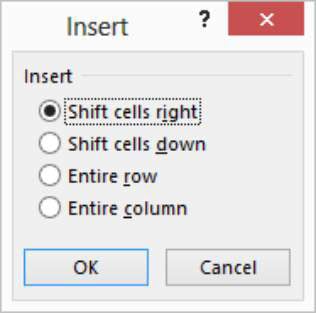In Excel 2013, you can insert and delete individual cells or even ranges that don’t neatly correspond to entire rows or columns. When you do so, the surrounding cells shift. In the case of an insertion, cells move down or to the right of the area where the new cells are being inserted. In the case of a deletion, cells move up or to the left to fill in the voided space.
Deleting a cell is different from clearing a cell’s content, and this becomes apparent when you start working with individual cells and ranges. When you clear the content, the cell itself remains. When you delete the cell itself, the adjacent cells shift.
When shifting cells, Excel is smart enough that it tries to guess which direction you want existing content to move when you insert or delete cells. If you have content immediately to the right of a deleted cell, for example, Excel shifts it left. If you have content immediately below the deleted cell, Excel shifts it up. You can still override that, though, as needed.
In the following exercise, you insert and delete cells.
In the Lesson 5 Mortgage file from the preceding exercise, select A1:A6 and then choose Home→Delete.
Excel guesses that you want to move the existing content to the left, and it does so.
Click cell A1, and choose Home→Insert.
Excel guesses that you want to move the existing content down, which is incorrect. The content in column B is off by one row, as shown in this figure.

Press Ctrl+Z to undo the insertion; then from the Home tab, click the down arrow to the right of the Insert button and choose Insert Cells.
The Insert dialog box opens, as shown.

Select Shift Cells Right and then click OK.
A new cell A1 is inserted, and the previous A1 content moves into B1.
Save the changes to the workbook.

